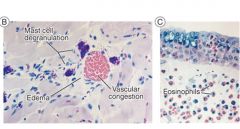![]()
![]()
![]()
Use LEFT and RIGHT arrow keys to navigate between flashcards;
Use UP and DOWN arrow keys to flip the card;
H to show hint;
A reads text to speech;
21 Cards in this Set
- Front
- Back
- 3rd side (hint)
|
local and systemic diseases
|
local: urticaria (hives), angioedema (lips, tongue, eyes), allergic rhinitis/conjunctivitis (hay fever), allergic gastroenteritis, asthma
systemic anaphylaxis |
|
|
|
immediate and late response of type I
|
immediate: vasodilation, vascular leakage, smooth muscle spasm
late: leukocyte infiltration, epithelial damage, bronchospasm |

|
|
|
primary and secondary mediators produced by mast cells and basophils
|
primary: biogenic amines (histamine), enzymes (proteinase and hydrolase), proteoglycans
secondary: lipid-derived mediators (from membrane phospholipids) - leukotrienes, prostaglandin, platelet activating factor cytokines |
|
|
|
Biogenic amines (histamine)
|
smooth muscle contraction
increased vascular permeability increased secretion by nasal, bronchial and gastric glands |
|
|
|
enzymes (protease, hydrolase)
|
tissue damage
generate kinins and activate complements |
|
|
|
proteoglycans (heparin)
|
serve to package and store other mediators
|
|
|
|
leukotrienes
|
increase vascular permeability and bronchial smooth muscle contraction
chemotactic for eosinophils |
|
|
|
prostaglandin
|
bronchspasm
increased mucus secretion |
|
|
|
platelet activating factors (PAF)
|
platelet aggregation
release of histamine chemotactic for eosinophils |
|
|
|
cytokines
|
participate in late phase response
|
|
|
|
urticaria (hives, wheals)
|
edema of superficial dermis
lesions appear rapidly and fade within hrs - episodes may last for days |

pruritic slightly elevated areas on the skin which are redder or paler than the surrounding skin
|
|
|
angioedema
|
deeper edema of both dermis and subcutaneous fat (lips, tongue and eyes)
|
|
|
|
hereditary angioneurotic edema
|
C1 inhibitor deficiency
not related to Type I hypersensitivity |
|
|
|
allergic rhinitis/allergic conjunctivitis (hay fever)
|
affects 20% of population
mucosal edema, redness and mucous secretion secretions and mucosa contain numerous eosinophils |
|
|
|
bronchial asthma (extrinsic)
|
most common type of asthma
hyperreactive airways leading to bronchoconstriction - dyspnea, couphing, wheezing triggered by bronchospasm overdistended lungs, occlusion of bronchioles with mucous plus edema, increased submucosal glands, hypertrophy of bronchial wall musle, esosinophils |

|
|
|
neutral proteases
|
activation of complement and kinins contributes to mast cell degranulation
causes tissue damage |
|
|
|
systemic anaphylaxis
|
widespread edema, respiratory distress, vascular shock
loss of consciousness hives swelling of tongues, inability to swallow rapid swelling of throat tissues (laryngeal edema) hypotension and dizziness |
|
|
|
anaphylaxis treatment with ABC
|
A - adrenalin (reverse histamine response)
B - Benadryl (anti histamine) C - corticosteroids |
|
|
|
epinephrine and theophylline
|
drug of choice for acute emergency Tc
vasoconstriction via alpha1 bronchodilation and blocks degranulation through beta 2 |
|
|
|
corticosteroids is for
|
for recurrent patients
|
|
|
|
antihistamines given when?
|
given after pt is stabilized
|
|

